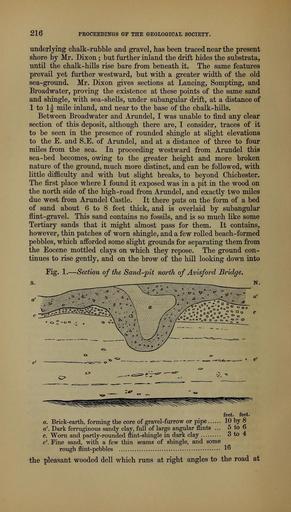MAKE A MEME
View Large Image

| View Original: | The_Quarterly_journal_of_the_Geological_Society_of_London_(12981116063).jpg (1162x2045) | |||
| Download: | Original | Medium | Small | Thumb |
| Courtesy of: | commons.wikimedia.org | More Like This | ||
| Keywords: The Quarterly journal of the Geological Society of London (12981116063).jpg 216 <br> PROCEEDOrGS OF TKE GEOLOGICAL SOCIETY <br> underlying chalk-rubble and gravel has been traced near the present <br> shore by Mr Dixon ; but further inland the drift hides the substrata <br> untn the chalk-hills rise bare from beneath it The same features <br> prevail yet further westward but with a greater width of the old <br> sea-ground Mr Dixon gives sections at Lancing Sompting and <br> Broadwater proving the existence at these points of the same sand <br> and shingle with sea-shells under subangular drift at a distance of <br> 1 to 1 mile inland and near to the base of the chalk-hills <br> Between Broadwater and Arundel I was unable to find any clear <br> section of this deposit although there are I consider traces of it <br> to be seen in the presence of rounded shingle at slight elevations <br> to the E and S E of Arundel and at a distance of three to four <br> miles from the sea In proceeding westward from Arundel this <br> sea -bed becomes owing to the greater height and more broken <br> nature of the ground much more distinct and can be followed with <br> little difficulty and with but slight breaks to beyond Chichester <br> The first place where I found it exposed was in a pit in the wood on <br> the north side of the high-road from Arundel and exactly two miles <br> due west from Arundel Castle It there puts on the form of a bed <br> of sand about 6 to 8 feet thick and is overlaid by subangular <br> flint-gravel This sand contains no fossils and is so much like some <br> Tertiary sands that it might almost pass for them It contains <br> however thin patches of worn shingle and a few rolled beach-formed <br> pebbles which afforded some slight grounds for separating them from <br> the Eocene mottled clays on which they repose The ground con- <br> tinues to rise gently and on the brow of the hill looking down into <br> Fig 1 ” Section of the Sand-pit north of Avisford Bridge <br> s ___ ” _ _ N <br> feet feet <br> a Brick-earth forming the core of gravel-furrow or pipe 10 by 8 <br> a' Dark ferruginous sandy clay full of large angular flints 5 to 6 <br> c Worn and partly-rounded flint-sMngle in dark clay 3to4 <br> c' Fine sand with a few thin seams of shingle and some <br> rough flint-pebbles 16 <br> the pleasant wooded dell which runs at right angles to the road at 36161759 111474 51125 Page 216 Text v 15 http //www biodiversitylibrary org/page/36161759 1859 Geological Society of London Biodiversity Heritage Library The Quarterly journal of the Geological Society of London v 15 1859 Geology Periodicals Smithsonian Libraries bhl page 36161759 dc identifier http //biodiversitylibrary org/page/36161759 smithsonian libraries Information field Flickr posted date ISOdate 2014-03-07 Check categories 2015 August 26 CC-BY-2 0 BioDivLibrary https //flickr com/photos/61021753 N02/12981116063 2015-08-26 14 52 43 cc-by-2 0 PD-old-70-1923 The Quarterly journal of the Geological Society of London 1859 Photos uploaded from Flickr by Fæ using a script | ||||